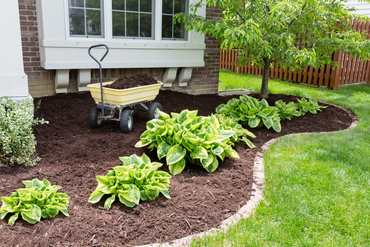
Mulching your garden once a year is one of the simplest and most effective ways to improve soil health, boost plant growth and keep your garden looking its best. A good mulch not only nourishes the soil but also helps you grow stronger, healthier plants with less effort. Here’s everything you need to know about mulching and why autumn is the perfect time to get started.
What is Mulching?
Mulching means covering the soil with a protective layer of material. Most gardeners use organic materials such as compost, bark chippings or leaf mould but decorative options like slate, pebbles or pea shingle are also popular.
Mulching offers several benefits:
- Suppresses weeds by blocking sunlight, preventing weed seeds from germinating.
- Reduces water loss by slowing evaporation, which helps plants cope better during dry spells.
- Improves soil structure when organic mulches are broken down by worms and soil organisms, making clay soils lighter and sandy soils better at retaining moisture.
- Adds nutrients to the soil, feeding plants and encouraging vigorous growth.

Types of Mulch
Organic Mulches
- Garden compost, leaf mould, or well-rotted manure: Perfect for vegetable patches and perennial beds, adding nutrients and improving soil texture.
- Bark chips: Long-lasting and excellent for weed suppression, especially around deep-rooted plants like shrubs and trees. They do absorb a little nitrogen as they decompose, so they’re best kept for ornamental beds and borders.
Inorganic Mulches
- Slate, pebbles, or shingle: Great for a smart, decorative finish while reducing evaporation and helping to suppress weeds. However, they won’t improve soil structure in the same way organic mulches do.

How to Mulch Your Garden
Mulching is straightforward, but timing and technique make all the difference. The best times are autumn, once plants have died back or early spring, before new growth begins.
- Prepare the ground: Clear away weeds, fallen leaves, and old plant material. Cut back perennials that have finished for the season.
- Check soil moisture: The soil should be moist before you mulch. Avoid mulching frozen ground, as mulch will trap the cold and keep soil frozen for longer.
- Apply a thick layer: Spread mulch evenly at a depth of at least 5cm (2 inches). If supplies are limited, focus on smaller areas with a thick layer rather than spreading it too thinly across the whole garden.
- Protect plants: Keep mulch away from the crowns of perennials and the trunks of shrubs and trees to prevent rot.
Give Your Garden a Boost This Autumn
A fresh layer of mulch will protect your soil through winter, lock in moisture and set your plants up for a strong start next spring.
At our St Albans garden centre, we stock a fantastic range of organic and decorative mulches, plus top-quality soil improvers to suit every garden style and need. Visit us this autumn and give your garden the care it deserves!




